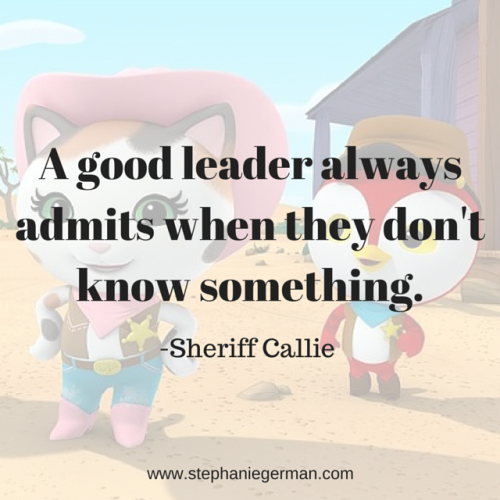If we define leadership as anyone who has influence, we can define leadership in the same way for cartoon characters.
I have a three-year-old which means we watch a lot of Disney Junior. Some of the shows are educational, and some are just downright horrible to watch. It is amazing to me how many now have a leadership principles as the main lesson in the show.
Leadership Lessons in Unexpected Places
The other day we were watching Sheriff Callie on our AppleTV. The best thing about Apple TV, no commercials. No commercials means the child does not desire all that is advertised. But I digress.
My husband says what he has learned from Sheriff Callie is everything is better with a magic rope. While this may be true, most of us will never have a magic rope.
In one episode of Sheriff Callie, Hike to Wish Mountain, Deputy Peck says he knows the way to the top of Wish Mountain “like the back of his wing.” They all wanted to make it to the top of Wish Mountain in time to see the meteor shower and to make a wish.
Sheriff Callie: “Well, you can be our leader then.”
Deputy Peck: “You mean the leader leader?! Woo hoo! I mean, that sounds nice.”
Clearly, Peck was thrilled to be able to lead his friends up to Wish Mountain. As they start on their journey, it becomes obvious that Peck doesn’t quite remember the way to go. Or how to keep them all safe.
He is so excited to be the leader that he isn’t willing to tell them he doesn’t quite know the way.
He falls off a cliff and Sheriff Callie saves him. Then this happens:
Peck: “We made it, we really made it. I never thought I’d see the ground again. Never ever ever. And all because I took the wrong path.”
All: “Gasp”
Sheriff Callie: “What was that Deputy?”
Peck: “What I said was, well, um, I made a mistake. We are on the wrong path”
All: “The wrong path?! Why didn’t you tell us Peck?”
Peck: “Because then you wouldn’t think I was a good leader.”
Sheriff Callie: “Peck, there’s no shame in admitting when you’re wrong. In fact, a good leader always admits when they don’t know something.”
Peck: “Really? I didn’t know that.”
What I learned from Sheriff Callie: A Good Leader Always Admits When They Don’t Know Something…Sometimes
How I wish that statement was true across the board.
I have followed many leaders who acted like they knew it all, even when it was clear they didn’t. They would not listen to anyone’s suggestions regarding the situation in which they believed they had all of the answers.
There is nothing more discouraging than working for someone who is the smartest person in the room. The person who is never wrong. The leader who makes up an answer even if it isn’t close to being correct, simply to have an answer. A leader who diminishes others abilities and thoughts.
When a leader never admits they are wrong they:
Lose credibility
Lose the respect of those they lead
Do not seem as honest and trustworthy
Admitting Mistakes = Respect
I have worked for both types of leaders. The one who is never wrong and the one who admits when they make a mistake. When my leaders have admitted they are wrong it makes them human. It makes them more approachable in general, but especially when I have made a mistake.
Work on becoming the leader who is open to suggestions.
Work on becoming the leader who is approachable, for both the good and bad.
Work on becoming the leader who admits when they don’t know something.
You will be amazed at the correlation between admitting when you don’t know something and the level of respect and loyalty among your followers. There is power in the phrase “I am not sure, but I will find out.” My level of respect for individuals increases when they are able to say “I was wrong” or “I am sorry for…”
If you have never been a leader who has admitted mistakes before, the apology may seem like a one off and cause some mistrust at the beginning. However, when a leader chooses to put their own comfort to the side and admit when they are wrong, they begin to change the culture of the organization.
The best piece advice (after admitting you were wrong or don’t know) is to invite those you lead to find the answers or gather everyone together to brainstorm the answer. Create buy in. People want to be engaged in their jobs. Help them.
In conclusion…
I am thankful for the leadership lesson, for what I learned from Sheriff Callie that day. It was a great reminder for me as I navigate leading that I do not have to know all of the answers. Admitting when I don’t know something, when you don’t know something, can change the culture of your organization. It eventually equates to greater respect. This in turn gives us a chance to utilize our followers to find the answer. Empowering employees will make them feel more valuable to the organization, creating greater loyalty. People want to feel useful, not that they are being used.
Has there been a time when you pretended like you had the solution to the problem even though you had no idea what you were doing?
Do you think a good leader admits when they are wrong? Share below.
Here’s to the Journey!



Great post, Stephanie. I am the kind of person who has the hardest time admitting when I’m wrong; marriage has really helped me grow in this area. Thanks for sharing!
Glad you liked it! No one likes to admit when they are wrong as it takes humility, and we all seem to have a hard time with humility it seems.